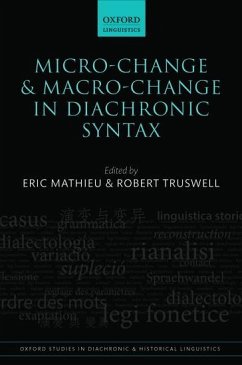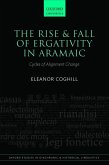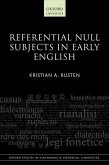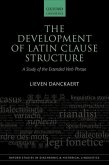Truswell Mathieu
MICRO-CH & MACRO-CH DIAC SYNT OSDHL 23 C
Truswell Mathieu
MICRO-CH & MACRO-CH DIAC SYNT OSDHL 23 C
- Gebundenes Buch
Andere Kunden interessierten sich auch für
![SYNT FEAT & LIMIT SYNT CHANGE OSDHL C SYNT FEAT & LIMIT SYNT CHANGE OSDHL C]() Eythorsson JonssonSYNT FEAT & LIMIT SYNT CHANGE OSDHL C138,99 €
Eythorsson JonssonSYNT FEAT & LIMIT SYNT CHANGE OSDHL C138,99 €![CLAUS STR & WOR ORD HIS GER OSDHL 28 C CLAUS STR & WOR ORD HIS GER OSDHL 28 C]() Jager Et AlCLAUS STR & WOR ORD HIS GER OSDHL 28 C156,99 €
Jager Et AlCLAUS STR & WOR ORD HIS GER OSDHL 28 C156,99 €![RISE & FALL ERGATIVIT ARAMAIC OSDHL 21 C RISE & FALL ERGATIVIT ARAMAIC OSDHL 21 C]() CoghillRISE & FALL ERGATIVIT ARAMAIC OSDHL 21 C160,99 €
CoghillRISE & FALL ERGATIVIT ARAMAIC OSDHL 21 C160,99 €![REFER NULL SUBJ IN EARL ENG OSDHL 35 C REFER NULL SUBJ IN EARL ENG OSDHL 35 C]() RustenREFER NULL SUBJ IN EARL ENG OSDHL 35 C115,99 €
RustenREFER NULL SUBJ IN EARL ENG OSDHL 35 C115,99 €![GENDER FROM LATIN TO ROMANCE OSDHL 27 C GENDER FROM LATIN TO ROMANCE OSDHL 27 C]() LoporcaroGENDER FROM LATIN TO ROMANCE OSDHL 27 C151,99 €
LoporcaroGENDER FROM LATIN TO ROMANCE OSDHL 27 C151,99 €![DEVELOPMENT LATIN CLAUSE STRUCT OSDHL C DEVELOPMENT LATIN CLAUSE STRUCT OSDHL C]() DanckaertDEVELOPMENT LATIN CLAUSE STRUCT OSDHL C124,99 €
DanckaertDEVELOPMENT LATIN CLAUSE STRUCT OSDHL C124,99 €![WORD ORDER CHANGE OSDHL C WORD ORDER CHANGE OSDHL C]() Cardoso MartinsWORD ORDER CHANGE OSDHL C129,99 €
Cardoso MartinsWORD ORDER CHANGE OSDHL C129,99 €-
-
-
Produktdetails
- Verlag: ACADEMIC
- Seitenzahl: 348
- Erscheinungstermin: 6. Juli 2017
- Englisch
- Abmessung: 240mm x 161mm x 23mm
- Gewicht: 687g
- ISBN-13: 9780198747840
- ISBN-10: 0198747845
- Artikelnr.: 47867039
- Herstellerkennzeichnung
- Libri GmbH
- Europaallee 1
- 36244 Bad Hersfeld
- gpsr@libri.de
Eric Mathieu is Associate Professor at the University of Ottawa. He completed his PhD in 2002 at University College London. His research focuses on Modern and Old French, and on the Algonquian language Ojibwe. His work has been published in a number of journals including Linguistic Inquiry, Natural Language and Linguistic Theory, Lingua, Probus, and Linguistic Variation. He is also co-author of The Syntax and Semantics of Split Constructions (Palgrave, 2004) and co-editor of Variation within and across Romance Languages (Benjamins, 2011). Robert Truswell is a Chancellor's Fellow in the school of Philosophy, Psychology, and Language Science at the University of Edinburgh and Adjunct Professor in the Department of Linguistics at the University of Ottawa. His research covers a range of topics associated with syntax-external influences on syntactic phenomena, and his previous OUP publications are Events, Phrases, and Questions (2011) and Syntax and its Limits (2013, with Raffaella Folli and Christina Sevdali). He is also the editor of the forthcoming Oxford Handbook of Event Structure.
* 1: Eric Mathieu and Robert Truswell: Micro-change and macro-change in
diachronic syntax
* 2: Ailís Cournane: In defence of the child innovator
* 3: Nikolas Gisborne and Robert Truswell: Where do relative specifiers
come from?
* 4: John Whitman and Yohei Ono: Diachronic interpretations of word
order parameter cohesion
* 5: Katalin É. Kiss: The rise and fall of Hungarian complex tenses
* 6: Gertjan Postma: Modelling transient states in language change
* 7: Hezekiah Akiva Bacovcin: Modelling interactions between
morphosyntactic changes
* 8: Michelle Troberg and Heather Burnett: From Latin to Modern French:
A punctuated shift
* 9: Nikolaos Lavidas: Case in diachrony: Or, why Greek is not English
* 10: Marie Labelle and Paul Hirschbühler: Leftward Stylistic
Displacement (LSD) in Medieval French
* 11: Christine Meklenborg Salvesen and George Walkden: Diagnosing
embedded V2 in Old English and Old French
* 12: Caitlin Light: The pragmatics of demonstratives in Germanic
* 13: Aaron Ecay and Meredith Tamminga: Persistence as a diagnostic of
grammatical status: The case of Middle English negation
* 14: Lieven Danckaert: The origins of the Romance analytic passive:
Evidence from word order
* 15: Sarah G. Courtney: Reconciling syntactic and post-syntactic
complementizer agreement
* 16: Lukasz Jedrzejowski: On the grammaticalization of
temporal-aspectual heads: The case of German versprechen 'promise'
diachronic syntax
* 2: Ailís Cournane: In defence of the child innovator
* 3: Nikolas Gisborne and Robert Truswell: Where do relative specifiers
come from?
* 4: John Whitman and Yohei Ono: Diachronic interpretations of word
order parameter cohesion
* 5: Katalin É. Kiss: The rise and fall of Hungarian complex tenses
* 6: Gertjan Postma: Modelling transient states in language change
* 7: Hezekiah Akiva Bacovcin: Modelling interactions between
morphosyntactic changes
* 8: Michelle Troberg and Heather Burnett: From Latin to Modern French:
A punctuated shift
* 9: Nikolaos Lavidas: Case in diachrony: Or, why Greek is not English
* 10: Marie Labelle and Paul Hirschbühler: Leftward Stylistic
Displacement (LSD) in Medieval French
* 11: Christine Meklenborg Salvesen and George Walkden: Diagnosing
embedded V2 in Old English and Old French
* 12: Caitlin Light: The pragmatics of demonstratives in Germanic
* 13: Aaron Ecay and Meredith Tamminga: Persistence as a diagnostic of
grammatical status: The case of Middle English negation
* 14: Lieven Danckaert: The origins of the Romance analytic passive:
Evidence from word order
* 15: Sarah G. Courtney: Reconciling syntactic and post-syntactic
complementizer agreement
* 16: Lukasz Jedrzejowski: On the grammaticalization of
temporal-aspectual heads: The case of German versprechen 'promise'
* 1: Eric Mathieu and Robert Truswell: Micro-change and macro-change in
diachronic syntax
* 2: Ailís Cournane: In defence of the child innovator
* 3: Nikolas Gisborne and Robert Truswell: Where do relative specifiers
come from?
* 4: John Whitman and Yohei Ono: Diachronic interpretations of word
order parameter cohesion
* 5: Katalin É. Kiss: The rise and fall of Hungarian complex tenses
* 6: Gertjan Postma: Modelling transient states in language change
* 7: Hezekiah Akiva Bacovcin: Modelling interactions between
morphosyntactic changes
* 8: Michelle Troberg and Heather Burnett: From Latin to Modern French:
A punctuated shift
* 9: Nikolaos Lavidas: Case in diachrony: Or, why Greek is not English
* 10: Marie Labelle and Paul Hirschbühler: Leftward Stylistic
Displacement (LSD) in Medieval French
* 11: Christine Meklenborg Salvesen and George Walkden: Diagnosing
embedded V2 in Old English and Old French
* 12: Caitlin Light: The pragmatics of demonstratives in Germanic
* 13: Aaron Ecay and Meredith Tamminga: Persistence as a diagnostic of
grammatical status: The case of Middle English negation
* 14: Lieven Danckaert: The origins of the Romance analytic passive:
Evidence from word order
* 15: Sarah G. Courtney: Reconciling syntactic and post-syntactic
complementizer agreement
* 16: Lukasz Jedrzejowski: On the grammaticalization of
temporal-aspectual heads: The case of German versprechen 'promise'
diachronic syntax
* 2: Ailís Cournane: In defence of the child innovator
* 3: Nikolas Gisborne and Robert Truswell: Where do relative specifiers
come from?
* 4: John Whitman and Yohei Ono: Diachronic interpretations of word
order parameter cohesion
* 5: Katalin É. Kiss: The rise and fall of Hungarian complex tenses
* 6: Gertjan Postma: Modelling transient states in language change
* 7: Hezekiah Akiva Bacovcin: Modelling interactions between
morphosyntactic changes
* 8: Michelle Troberg and Heather Burnett: From Latin to Modern French:
A punctuated shift
* 9: Nikolaos Lavidas: Case in diachrony: Or, why Greek is not English
* 10: Marie Labelle and Paul Hirschbühler: Leftward Stylistic
Displacement (LSD) in Medieval French
* 11: Christine Meklenborg Salvesen and George Walkden: Diagnosing
embedded V2 in Old English and Old French
* 12: Caitlin Light: The pragmatics of demonstratives in Germanic
* 13: Aaron Ecay and Meredith Tamminga: Persistence as a diagnostic of
grammatical status: The case of Middle English negation
* 14: Lieven Danckaert: The origins of the Romance analytic passive:
Evidence from word order
* 15: Sarah G. Courtney: Reconciling syntactic and post-syntactic
complementizer agreement
* 16: Lukasz Jedrzejowski: On the grammaticalization of
temporal-aspectual heads: The case of German versprechen 'promise'









